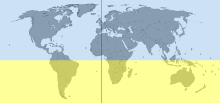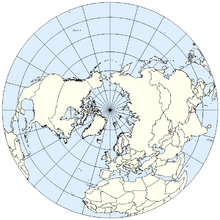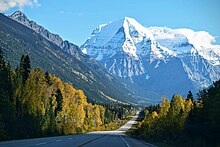Northern Hemisphere


The Northern Hemisphere is the half of Earth that is north of the Equator. For other planets in the Solar System, north is defined as being in the same celestial hemisphere relative to the invariable plane of the Solar System as Earth's North Pole.[1]
Due to Earth's
Its surface is 60.7% water, compared with 80.9% water in the case of the Southern Hemisphere, and it contains 67.3% of Earth's land.[3] The continents of North America and mainland Eurasia are located entirely in the Northern Hemisphere, together with about two-thirds of Africa and a small part of South America.
Geography and climate
During the 2.5 million years of the
The
Tropical regions (between the Tropic of Cancer and the Equator, 0° latitude) are generally hot all year round and tend to experience a rainy season during the summer months, and a dry season during the winter months.
In the Northern Hemisphere, objects moving across or above the surface of the Earth tend to turn to the right because of the

For the same reason, flows of air down toward the northern surface of the Earth tend to spread across the surface in a clockwise pattern. Thus, clockwise air circulation is characteristic of high pressure weather cells in the Northern Hemisphere. Conversely, air rising from the northern surface of the Earth (creating a region of low pressure) tends to draw air toward it in a counterclockwise pattern. Hurricanes and tropical storms (massive low-pressure systems) spin counterclockwise in the Northern Hemisphere.[8]
The shadow of a sundial moves clockwise on latitudes north of the subsolar point and anticlockwise to the south. During the day at these latitudes, the Sun tends to rise to its maximum at a southerly position. Between the Tropic of Cancer and the Equator, the sun can be seen to the north, directly overhead, or to the south at noon, depending on the time of year. In the Southern Hemisphere, the midday Sun is predominantly in the north.
When viewed from the Northern Hemisphere, the Moon appears inverted compared to a view from the Southern Hemisphere.[9][10] The North Pole faces away from the Galactic Center of the Milky Way. This results in the Milky Way being sparser and dimmer in the Northern Hemisphere compared to the Southern Hemisphere, making the Northern Hemisphere more suitable for deep-space observation, as it is not "blinded" by the Milky Way.[citation needed]
Demographics
As of 2015, the Northern Hemisphere is home to approximately 6.4 billion people which is around 87.0% of the earth's total human population of 7.3 billion people.[11][12][13]
List of continents, countries or territories, and oceans in the Northern Hemisphere
See also
- Southern Hemisphere
- Hemispheres of Earth
- Africa
- Asia
- Americas
- Europe
- Arctic Ocean
- Atlantic Ocean
- Indian Ocean
- Pacific Ocean
- North–South divide (disambiguation)
- Global North
Notes
- ^ a b The continent itself is entirely within the Northern Hemisphere. However, some overseas territories of the countries of France, Norway and the United Kingdom are in the Southern Hemisphere.
References
- S2CID 189842666. Archived from the original(PDF) on 2016-03-04. Retrieved 2018-09-26.
- ^ "Ocean Currents". National Geographic Society. 2019-07-01. Archived from the original on 2021-11-20. Retrieved 2020-10-16.
- ISBN 9781576072868. Archivedfrom the original on 22 January 2023. Retrieved 8 September 2016.
- ^ "Quaternary Period". National Geographic. 2017-01-06. Archived from the original on 2020-11-29. Retrieved 2022-05-06.
- ^ "How long can we expect the present Interglacial period to last?". U.S. Department of the Interior. Archived from the original on 2022-07-26. Retrieved 2022-05-06.
- ^ a b US Department of Commerce, National Oceanic and Atmospheric Administration. "Boundary Currents – Currents: NOAA's National Ocean Service Education". oceanservice.noaa.gov. Archived from the original on 2010-05-15. Retrieved 2020-07-31.
- ^ "How does the ocean affect climate and weather on land?". NOAA Ocean Exploration. U.S. Department of Commerce. Retrieved 21 November 2023.
- ^ "Hurricanes: Science and Society: Primary Circulation". www.hurricanescience.org. Archived from the original on 2010-12-28. Retrieved 2021-08-11.
- ^ Laura Spitler. "Does the Moon look different in the northern and southern hemispheres? (Beginner) – Curious About Astronomy? Ask an Astronomer". cornell.edu. Archived from the original on 4 November 2015. Retrieved 10 November 2015.
- ^ "Perspective of the Moon from the Northern and Southern Hemispheres". Archived from the original on 9 September 2017. Retrieved 22 October 2013.
- ^ Calculated from World Population Yearbook 2019(in thousands) World total population: 7,359,970 Northern Hemisphere population: 6,405,030 87.0% Southern Hemisphere population: 954,940 13.0% Note 1) If there is no data for 2019, the latest data was used. Note 2) Countries with land that straddles the equator are divided into half populations in each of the Northern and Southern Hemispheres.
- ^ "90% Of People Live In The Northern Hemisphere – Business Insider". Business Insider. 4 May 2012. Archived from the original on 19 January 2018. Retrieved 10 November 2015.
- ^ "GIC – Article". galegroup.com. Archived from the original on 18 April 2016. Retrieved 10 November 2015.
